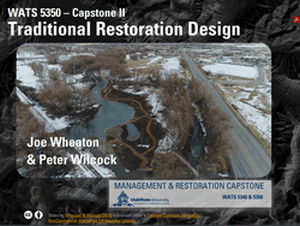Restoration Design - Geomorphic Principles
Background
Why we're covering it
- A review of design process and elaboration of concept of design hypotheses
- Crash-course on the ‘form’ side of geomorphology, as a grading plan is fundamentally a reflection of how your design changes those forms
- Help you understand the building blocks of riverscapes
- Introduce you to the tools and terminology to help you map riverscapes
Learning Outcomes
- Gain direct experience applying knowledge as a watershed scientist to working on real-world aquatic ecosystem restoration and management problems (e.g. stream restoration, watershed management, wetland restoration) with practitioners.
- Develop a working understanding of different aspects and approaches to restoration design and create two types of design and evaluate their ability to achieve project objectives. Articulate specific, testable design hypotheses for your own designs.
Resources
Slides & Handouts
Part 1 - Traditional Restoration Design
There are two lectures for this module. The first is a refresher on Traditional Restoration Design with emphasis on design hypothesis testing and explaining what a grading plan is (getting you ready for Module 2 on Grading).

Module 1 - Slides
Download Module 1 slides.
Part 2 - Geomorphic Principles Primer
The second lecture is a crash course on Geomorphic Principles to prepare you both for Module 2 on Grading and the LTPBR Project. As the topics are discrete and some of the parts of the lecture longer, I break them up into separate videos intended to be watched sequentially. There is about 1 hour and 20 minutes of lecture material, but if you do the 5 exercises, it will likely take you about 1 hour and 45 minutes to get through.
If you want to print out just the exercises:
Exercise Handout for Print
Download the exercise handout for print.

Module 1 - Part 2 Slides
Download Module 1 - Part 2 slides.
Relevant or Cited Literature
If you want more information on GUT:
- Kramer N, Bangen SG, Wheaton JM, Bouwes N, Wall E, Saunders C, and Bennett S. 2017. Geomorphic Unit Tool (GUT): Applications in Fluvial Mapping. EP11A-1546. AGU. New Orleans, LA, 11-15 Dec. DOI: 10.13140/RG.2.2.30142.18241.
- Bangen SG, Kramer N, Wheaton, JM, and Bouwes N. 2017. The GUTs of the Geomorphic Unit Tool: What is under the hood. EP31D-1901. AGU. New Orleans, LA, 11-15 Dec. DOI: 10.13140/RG.2.2.31118.66884.
For more information on what was covered in lecture, see optional reading:
- Fryirs K, Wheaton JM, and Brierley G. 2015. An approach for measuring confinement and assessing the influence of valley setting on river forms and processes. Earth Surface Processes & Landforms. DOI: 10.1002/esp.3893.
- Wheaton JM, Fryirs K, Brierley G, Bangen S, Bouwes N, and O’Brien G. 2015. Geomorphic Mapping and Taxonomy of Fluvial Landforms. Geomorphology. 248: 273-295. DOI: 10.1016/j.geomorph.2015.07.010
Or, take the WATS 5150 Fluvial Geomorphology Class
OLD - 2020 & Prior Lecture Slides
These are just for reference for past year's classes. Use slides and video above.
Previous Year In-Class Exercise Materials
Download all materials below to an easy to find place (e.g. c:\0_Logan).
- Exercise 1 - River Styles KMZ
- Exercise 2 - Hand out (mapping confining margins)
- Exercise 3 - Manual Mapping of Geomorphic Units - Download Merged & Clipped LiDAR 2015 and August 2016 Total Station Surveys - I recommend using this for today, grading plan and hydraulics. If you really want it, here is a 10 cm version (it's huge though!).
- Context: Hydraulics: Tyler Alred's Q2 and Q100 HEC-RAS-2D Depth Rasters - These were created based on 2015 LiDAR and HEC-RAS
- Exercise 6 - Inspecting Geomorphic Units: Logan River (Golf Course Road to 10th West) GUT 2.2.1 Project - This was run for the seven contiguous CHaMP topographic surveys from August 2016 from Golf Course Road to 10 West. I used the Geomorphic Unit Toolkit (GUT Version 2.2.1) individually on each reach and merged the inputs and outputs into one. If you want to run GUT yourself, see the documentation here. The video below walks you through an example of running GUT on the Logan (including explaining inputs):
- Optional Geomorphic Change Detection from April 2016 to August 2016 GCD 6 Project or GCD 7 Project - see this video for GCD 7